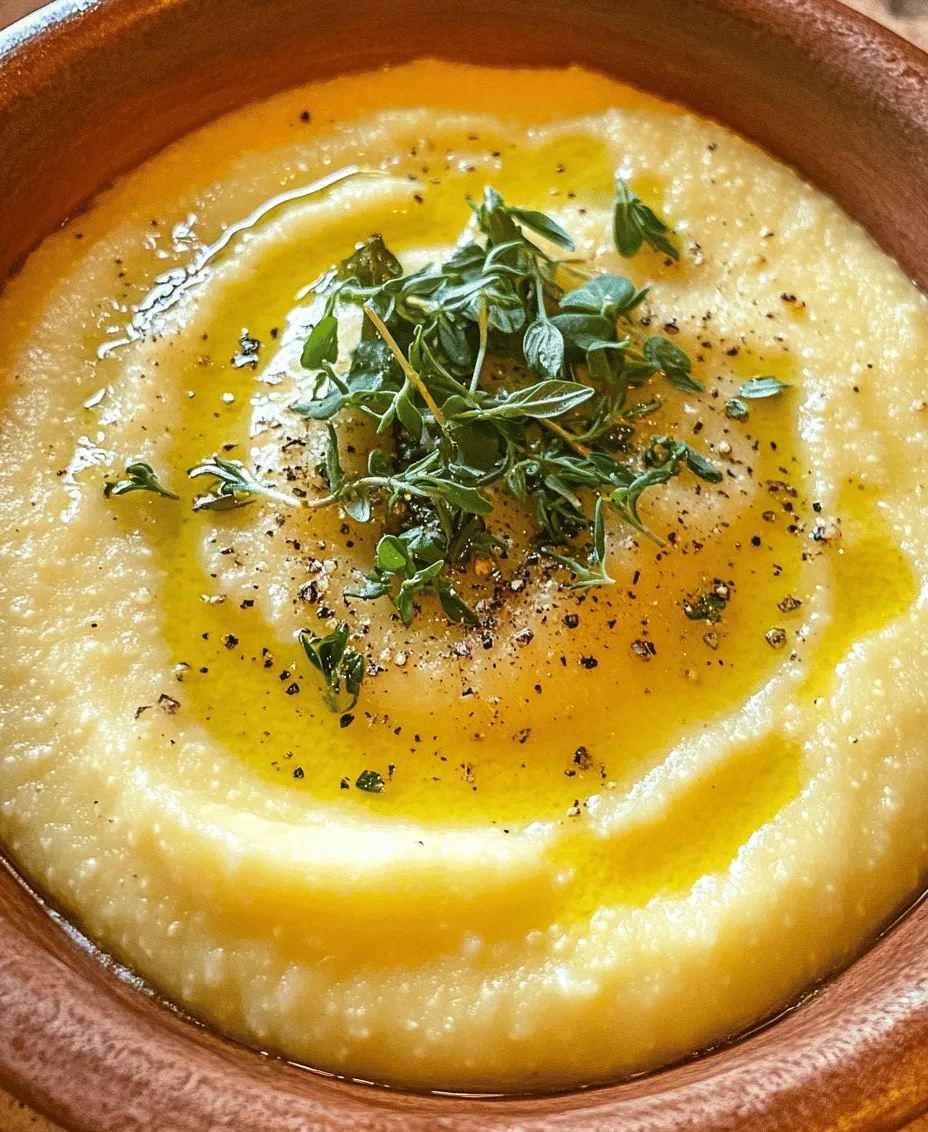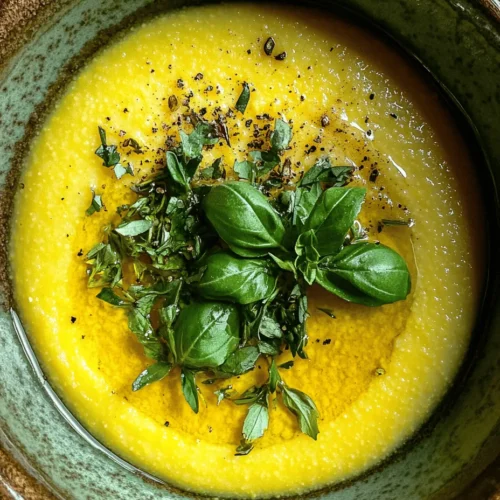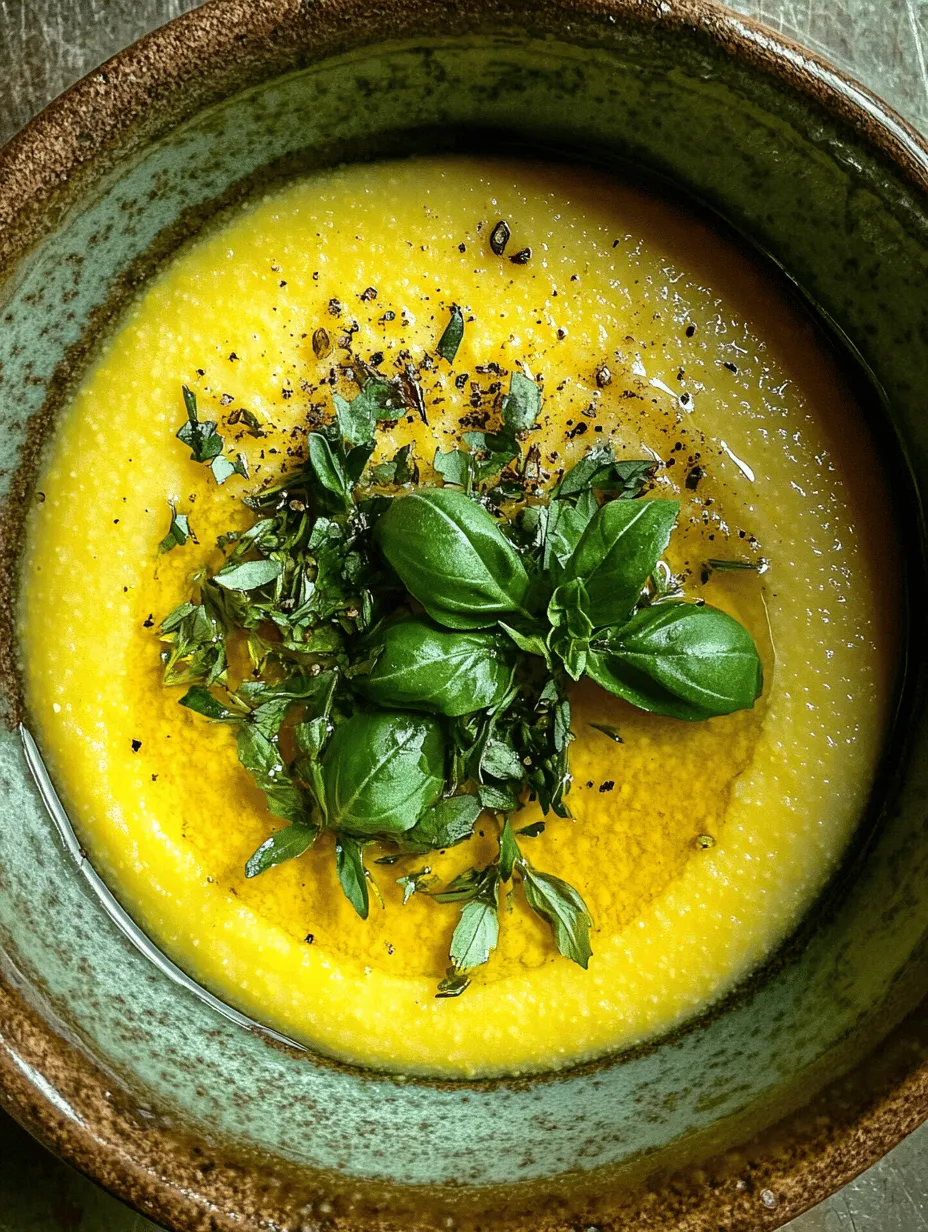Introduction
Polenta is a beloved dish that has transcended its humble origins to become a staple in kitchens around the world. This versatile and comforting dish, made primarily from ground cornmeal, is celebrated for its ability to adapt to various culinary styles and flavors. Whether served as a creamy base for hearty stews, molded into cakes and grilled to perfection, or simply enjoyed on its own, polenta has captured the hearts and palates of many.
Originating from Northern Italy, polenta has a rich cultural history that dates back centuries. Traditionally, it was a peasant food, made with coarse cornmeal and water, but its popularity has surged in recent years as home cooks rediscover the joys of making it from scratch. This article aims to provide you with a comprehensive guide to achieving perfectly creamy polenta, detailing everything from ingredient insights to step-by-step cooking instructions, and serving suggestions that will elevate your polenta experience.
Understanding Polenta
To fully appreciate polenta, it’s essential to delve into its history and cultural significance. In Italy, polenta has been a staple for centuries, often served alongside meats, sauces, and vegetables. It embodies the essence of Italian cuisine: simple, hearty, and deeply satisfying. In addition to Italy, variations of polenta can be found in various cultures, including South American and Eastern European cuisines, where it is often referred to as “cornmeal mush” or “mamaliga.”
The primary ingredient in polenta is cornmeal, which comes from ground yellow or white corn. While there are several types of cornmeal available, the coarse variety is most commonly used for traditional polenta. This coarser texture gives polenta its distinctive grainy feel and allows it to absorb flavors beautifully. The process of making polenta is relatively straightforward, but it does require patience and attention to achieve the ideal creamy consistency.
In addition to its cultural richness, polenta boasts several health benefits. It is naturally gluten-free, making it an excellent option for individuals with gluten sensitivities. Polenta is also a good source of carbohydrates, providing energy for your day. It contains essential nutrients, including vitamin A, B vitamins, and minerals like iron and magnesium, making it a nutritious addition to any meal.
Ingredients Breakdown
Before diving into the cooking process, it’s important to understand the role of each ingredient in creating perfectly creamy polenta. Here’s a closer look at the key components:
Polenta
The star of the dish, polenta, is made from ground cornmeal. When selecting polenta, look for high-quality, finely or coarsely ground cornmeal. The texture of polenta can greatly affect the final dish; coarser polenta takes longer to cook and results in a more rustic texture, while finer varieties yield a creamier consistency. The flavor of polenta is mild, allowing it to absorb the seasonings and ingredients it is paired with effectively.
Water or Broth
The liquid you use to cook polenta is crucial for flavor. While water is the most basic option, using broth—whether chicken, vegetable, or beef—adds depth and richness to the polenta. The broth infuses the dish with savory notes, enhancing the overall taste and making the polenta more satisfying.
Salt
Salt is an essential ingredient in cooking polenta. It enhances the flavor of the cornmeal and helps to bring out the dish’s natural sweetness. It’s important to add salt to the cooking liquid before adding the polenta, as this ensures even seasoning throughout the dish.
Olive Oil or Butter
When it comes to adding creaminess and richness to polenta, both olive oil and butter are excellent choices. Olive oil imparts a fruity, slightly peppery flavor, making it a healthier option high in monounsaturated fats. On the other hand, butter adds a rich, creamy taste that many find irresistible. You can use either or even a combination of both, depending on your preference and dietary needs.
Parmesan Cheese
For an authentic Italian touch, adding grated Parmesan cheese to your polenta is a must. Cheese not only contributes to the creamy texture but also adds a savory umami flavor, making the dish even more indulgent. For a dairy-free alternative, nutritional yeast can be used to impart a cheesy flavor without the calories.
Fresh Herbs
Garnishing your polenta with fresh herbs can elevate the dish’s presentation and flavor. Popular choices include basil, parsley, thyme, or chives, which can add a burst of color and freshness. These herbs not only enhance the taste but also provide additional nutrients.
Black Pepper
Finally, freshly cracked black pepper is an important seasoning that complements the flavors of polenta beautifully. It adds warmth and a slight kick, balancing the dish’s creaminess. Adjust the amount according to your taste preference, and don’t hesitate to experiment with other spices or herbs for added complexity.
Step-by-Step Cooking Instructions
Cooking polenta may seem intimidating at first, but with the right technique, you can achieve a perfectly creamy result. Here’s a detailed guide to making polenta from scratch, starting with the crucial first step: boiling the liquid.
Boiling the Liquid
1. Choose Your Cooking Liquid: Begin by deciding whether you will use water or broth. For a more flavorful polenta, broth is recommended. Measure out about 4 cups of liquid for every cup of polenta you plan to cook.
2. Bring to a Rolling Boil: In a large saucepan, pour in the measured liquid and place it over medium-high heat. Allow it to come to a rolling boil. This step is critical, as adding the polenta too early can lead to clumps and uneven cooking.
3. Add Salt: Once the liquid reaches a rolling boil, add a generous pinch of salt. This will season the polenta as it cooks, ensuring a well-balanced flavor. Stir the mixture briefly to dissolve the salt before proceeding.
4. Gradually Add Polenta: Reduce the heat to medium and slowly pour in the cornmeal while continuously whisking. This helps to prevent clumping and ensures even distribution of the polenta in the liquid. Keep whisking until all the cornmeal is incorporated.
5. Stir and Simmer: After adding the polenta, switch to a wooden spoon or spatula and stir the mixture continuously to prevent it from sticking to the bottom of the pot. Allow the polenta to simmer gently for about 30-40 minutes, depending on the coarseness of the cornmeal.
6. Monitor Consistency: As the polenta cooks, it will thicken significantly. Keep stirring every few minutes, scraping the bottom of the pot to prevent any sticking. If the polenta becomes too thick, you can add additional water or broth, a little at a time, to achieve your desired consistency.
By following these initial steps, you will be well on your way to mastering the art of creamy polenta. In the next section, we will explore additional steps and tips to enhance your polenta-making skills further. Stay tuned for more insights on perfecting this delightful dish!

Incorporating Polenta: Tips for a Smooth Texture
When cooking polenta, the key to achieving that velvety, creamy texture lies in how you incorporate the cornmeal into the boiling water. Start by bringing your water or broth to a rolling boil, then, while whisking continuously, gradually sprinkle in the cornmeal. This gradual incorporation helps prevent lumps from forming. If you notice any lumps forming despite your best efforts, don’t fret! Simply continue to whisk vigorously, or you can use an immersion blender to smooth it out once you’ve removed it from the heat.
Another important factor in ensuring a smooth texture is the type of cornmeal you use. Choose fine or medium-ground cornmeal for the best results, as coarser varieties can give a gritty texture. Also, consider the freshness of your cornmeal; older cornmeal may not hydrate as well, leading to a less-than-ideal consistency.
Simmering: The Perfect Cooking Process
Once you’ve added the cornmeal to your boiling liquid, reduce the heat to low and allow the mixture to simmer. The simmering process is crucial for the polenta to cook evenly and absorb the liquid. Stir the polenta frequently to prevent it from sticking to the bottom of the pot and to ensure even cooking.
You’ll know your polenta is done when it pulls away from the sides of the pot and has a creamy consistency. This usually takes about 30 to 40 minutes, depending on the coarseness of your cornmeal. Keep an eye on the texture; it should be thick but still pourable. If you prefer a firmer polenta that can be sliced, you can cook it a little longer.
Adding Fat and Cheese: Enhancing Flavor and Texture
To elevate your polenta from simple to spectacular, don’t skip the addition of fat and cheese. Once your polenta is finished cooking, stir in butter, olive oil, or heavy cream. These fats not only enrich the flavor but also contribute to that lush, creamy texture you’re aiming for.
For an extra burst of flavor, fold in grated cheese such as Parmesan, Pecorino Romano, or a creamy goat cheese. The cheese melts into the hot polenta, creating a delightful creaminess and a savory depth of flavor. The quantity of cheese can be adjusted according to your taste preferences, but a good rule of thumb is to use about 1 cup of cheese for every cup of dry cornmeal.
Adjusting Consistency: Achieving Creamy Perfection
Every cook has a different preference for the consistency of polenta, and achieving the perfect creamy texture is all about knowing how to adjust it. If your polenta turns out too thick, simply whisk in a little more warm water or broth until you reach your desired consistency. Conversely, if it’s too thin, return it to the heat and let it simmer a little longer, stirring frequently.
When adjusting the consistency, be mindful of how the polenta will be used. If you’re serving it as a side dish, a slightly thicker polenta can hold its shape better, while a creamier version works wonderfully as a base for soups or stews.
Seasoning: Perfecting the Flavor Profile
Seasoning is crucial in bringing out the best in your polenta. As with any dish, tasting as you go is the best practice. Start with a generous pinch of salt at the beginning of cooking, as it enhances the corn’s natural sweetness. After the polenta has cooked and you’ve added your fats and cheese, taste again and adjust the seasoning as necessary.
You may want to incorporate additional flavors such as garlic powder, onion powder, or fresh herbs like thyme or rosemary for extra depth. A dash of freshly cracked black pepper can also elevate the dish, providing a subtle heat that complements the creamy texture.
Serving Suggestions: Creative Ways to Enjoy Polenta
Polenta is incredibly versatile and can be served in numerous delicious ways. Here are some creative serving ideas to inspire your next meal:
Pairing with Proteins: Creamy polenta serves as a fantastic base for proteins. Consider pairing it with grilled chicken, sautéed shrimp, or braised meats. The creamy texture of the polenta contrasts beautifully with the savory flavors of the protein, creating a balanced dish.
Vegetarian Options: For a vegetarian-friendly meal, top your polenta with roasted vegetables, such as bell peppers, zucchini, and eggplant, drizzled with a balsamic reduction. Alternatively, consider a hearty sauce made with lentils or chickpeas, which can add both protein and flavor.
Breakfast Polenta: Polenta can easily transition to breakfast! Serve it topped with a fried egg, sautéed greens, or even fresh fruit and a drizzle of honey or maple syrup for a sweet twist. It’s a comforting and nutritious way to start your day.
Polenta as a Side Dish: Polenta also shines as a side dish. Its creamy texture pairs well with a variety of main courses, from rich stews to grilled meats. You can even slice cooled polenta into rounds and grill or fry them for a crispy side.
Nutritional Benefits of Polenta
Polenta is not just a comforting dish; it also offers several health benefits. Made from corn, it is a great source of carbohydrates, providing energy for your body. Additionally, polenta is naturally gluten-free, making it an excellent choice for those with gluten sensitivities or celiac disease.
In terms of nutrition, polenta contains fiber, which aids in digestion, and essential nutrients like vitamin A and certain B vitamins. When served with nutrient-dense toppings like vegetables or proteins, it can contribute to a balanced meal that fits well within vegetarian and gluten-free diets.
Conclusion
Cooking creamy polenta is a straightforward process that rewards you with a dish full of comfort and flavor. The key points to remember include incorporating the cornmeal gradually, simmering it to perfection, and enriching it with fats and cheeses to enhance the texture and taste. With endless possibilities for serving and pairing, polenta can easily adapt to any meal, whether it’s breakfast, lunch, or dinner.
We encourage you to experiment with this recipe and make it your own. Whether you enjoy it with savory proteins, roasted veggies, or as part of a hearty breakfast, homemade polenta is a delightful dish that celebrates the joy of simple, comforting food. So roll up your sleeves, grab your ingredients, and start your journey into the wonderful world of creamy polenta!



